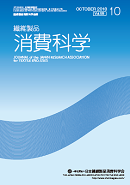
- |<
- <
- 1
- >
- >|
-
[in Japanese]2018Volume 59Issue 10 Pages 728-729
Published: October 25, 2018
Released on J-STAGE: October 25, 2018
JOURNAL RESTRICTED ACCESSDownload PDF (835K)
-
[in Japanese]2018Volume 59Issue 10 Pages 730-733
Published: October 25, 2018
Released on J-STAGE: October 25, 2018
JOURNAL RESTRICTED ACCESSDownload PDF (1814K)
-
[in Japanese]2018Volume 59Issue 10 Pages 734
Published: October 25, 2018
Released on J-STAGE: October 25, 2018
JOURNAL RESTRICTED ACCESSDownload PDF (610K) -
[in Japanese]2018Volume 59Issue 10 Pages 735-741
Published: October 25, 2018
Released on J-STAGE: October 25, 2018
JOURNAL RESTRICTED ACCESSDownload PDF (2274K)
-
[in Japanese]2018Volume 59Issue 10 Pages 742-743
Published: October 25, 2018
Released on J-STAGE: October 25, 2018
JOURNAL RESTRICTED ACCESSDownload PDF (920K) -
[in Japanese]2018Volume 59Issue 10 Pages 744-751
Published: October 25, 2018
Released on J-STAGE: October 25, 2018
JOURNAL RESTRICTED ACCESSDownload PDF (4031K)
-
[in Japanese]2018Volume 59Issue 10 Pages 752-757
Published: October 25, 2018
Released on J-STAGE: October 25, 2018
JOURNAL RESTRICTED ACCESSDownload PDF (1556K) -
[in Japanese]2018Volume 59Issue 10 Pages 758-761
Published: October 25, 2018
Released on J-STAGE: October 25, 2018
JOURNAL RESTRICTED ACCESSDownload PDF (1761K) -
[in Japanese]2018Volume 59Issue 10 Pages 762-765
Published: October 25, 2018
Released on J-STAGE: October 25, 2018
JOURNAL RESTRICTED ACCESSDownload PDF (1937K)
-
[in Japanese]2018Volume 59Issue 10 Pages 766-770
Published: October 25, 2018
Released on J-STAGE: October 25, 2018
JOURNAL RESTRICTED ACCESSDownload PDF (1336K)
-
[in Japanese]2018Volume 59Issue 10 Pages 771-774
Published: October 25, 2018
Released on J-STAGE: October 25, 2018
JOURNAL RESTRICTED ACCESSDownload PDF (2103K) -
[in Japanese]2018Volume 59Issue 10 Pages 775-779
Published: October 25, 2018
Released on J-STAGE: October 25, 2018
JOURNAL RESTRICTED ACCESSDownload PDF (2236K) -
[in Japanese]2018Volume 59Issue 10 Pages 780-783
Published: October 25, 2018
Released on J-STAGE: October 25, 2018
JOURNAL RESTRICTED ACCESSDownload PDF (1650K)
-
― Evaluation by the Newly Developed Stiffness Method ―Yukiyo KITAJIMA, Masako SAITO2018Volume 59Issue 10 Pages 784-793
Published: October 25, 2018
Released on J-STAGE: October 25, 2018
JOURNAL FREE ACCESSWhen restore the lacerated historic textiles, mostly the textiles of present day are used to support and protect them. The performance and the average life expectancy of the restored textiles are dependent on the conformity between the two textiles (historic and supporting textiles). So the selection of the supporting textiles is very important, but mostly the selections are done by only touching by hands and decided without reliable standard data. In this research, we aimed to clarify the conformity between the historic and supporting textiles by their stiffness. At the first step, we developed the new method of measuring the textile stiffness, and measured 127 silk textiles of different eras, and compared the data with heart-loop method of JIS-L-1096 and confirmed the validity of this new method (Bending Curve Test). From the results, we clarified their characteristics (thickness, weight, density, weave) and stiffness data of Kosode fragments of the Edo era, Kimono fragments after the Meiji era and several supporting silk fabrics quantitatively. The stiffness of silk fabrics varied depending on their weaving, and Kosode Fragments in the Edo era were thinner, softer and lighter compared to those of Kimono fragments after the Meiji era.
View full abstractDownload PDF (3691K)
-
[in Japanese]2018Volume 59Issue 10 Pages 794
Published: October 25, 2018
Released on J-STAGE: October 25, 2018
JOURNAL RESTRICTED ACCESSDownload PDF (537K)
-
[in Japanese]2018Volume 59Issue 10 Pages 807-808
Published: October 25, 2018
Released on J-STAGE: October 25, 2018
JOURNAL RESTRICTED ACCESSDownload PDF (1133K) -
[in Japanese], [in Japanese], [in Japanese]2018Volume 59Issue 10 Pages 809
Published: October 25, 2018
Released on J-STAGE: October 25, 2018
JOURNAL RESTRICTED ACCESSDownload PDF (790K) -
[in Japanese]2018Volume 59Issue 10 Pages 810-812
Published: October 25, 2018
Released on J-STAGE: October 25, 2018
JOURNAL RESTRICTED ACCESSDownload PDF (1313K)
-
[in Japanese]2018Volume 59Issue 10 Pages 813
Published: October 25, 2018
Released on J-STAGE: October 25, 2018
JOURNAL RESTRICTED ACCESSDownload PDF (924K)
-
2018Volume 59Issue 10 Pages 814
Published: October 25, 2018
Released on J-STAGE: October 25, 2018
JOURNAL RESTRICTED ACCESSDownload PDF (635K)
-
2018Volume 59Issue 10 Pages 815
Published: October 25, 2018
Released on J-STAGE: October 25, 2018
JOURNAL RESTRICTED ACCESSDownload PDF (584K)
- |<
- <
- 1
- >
- >|